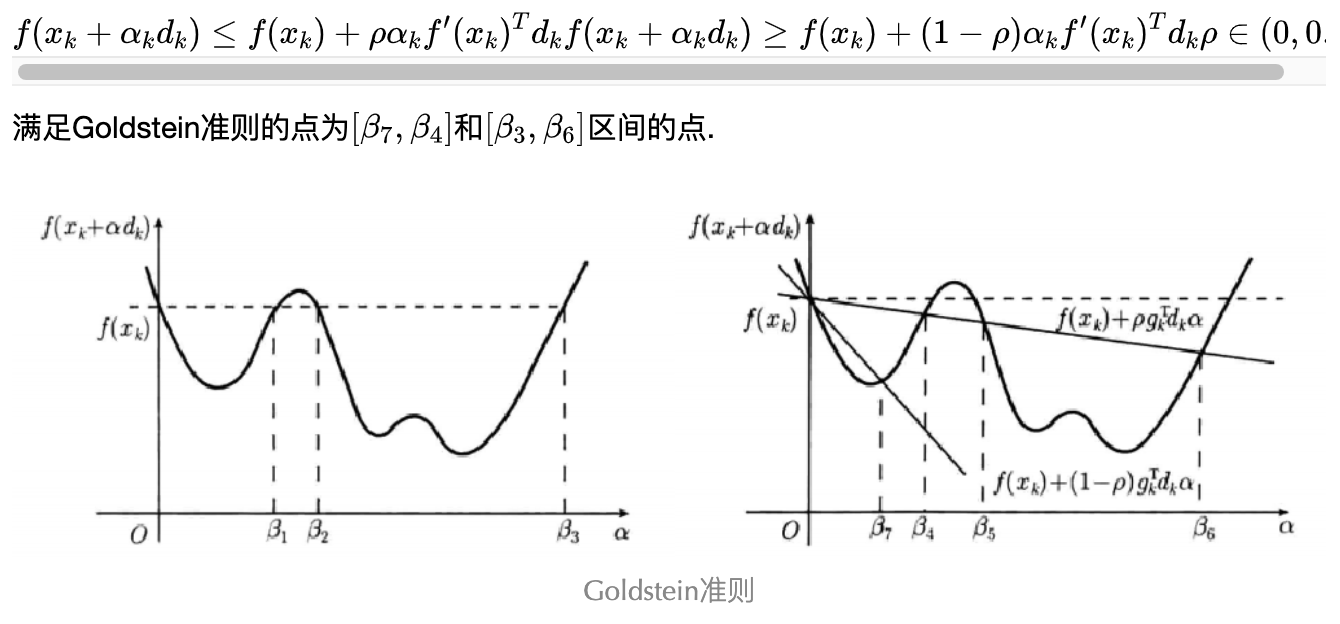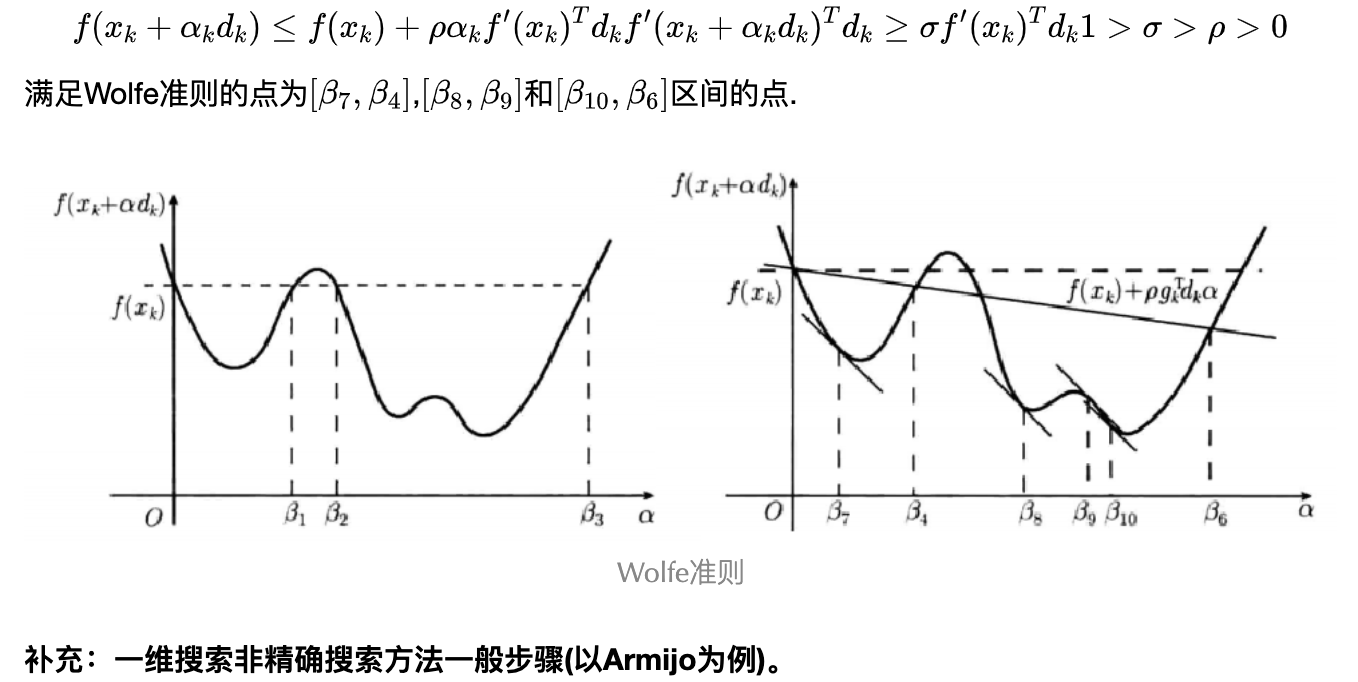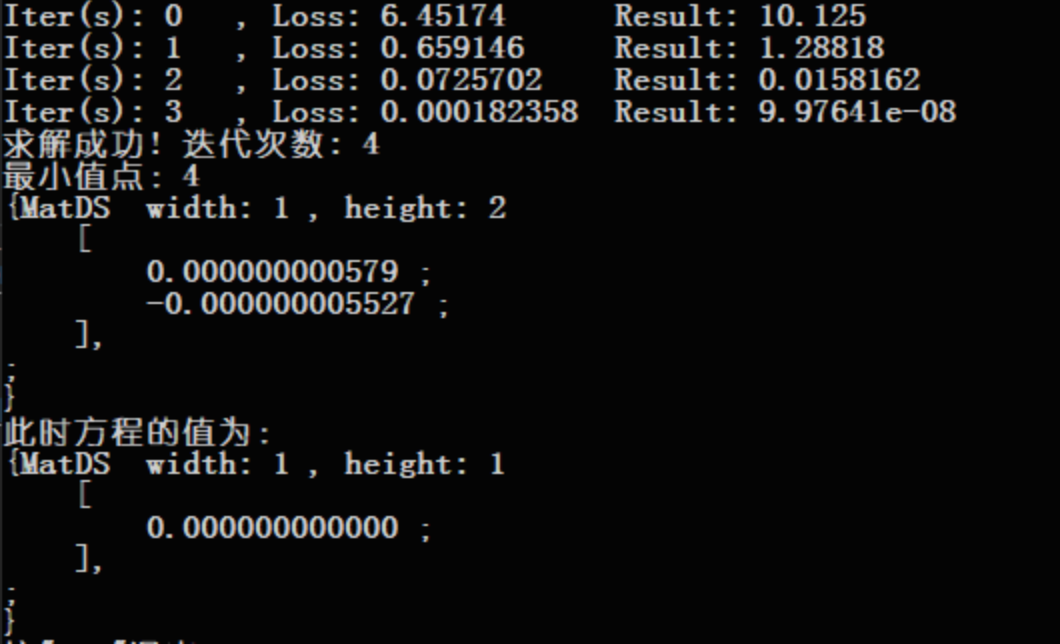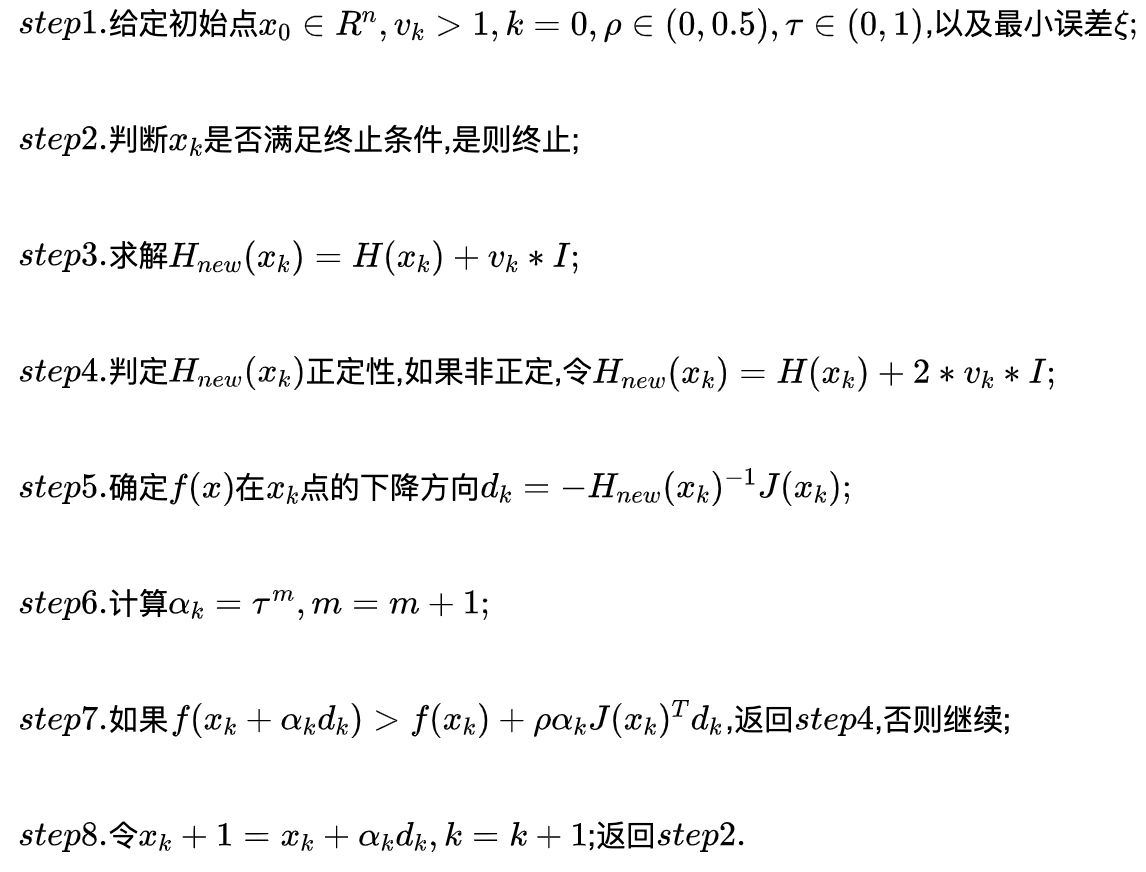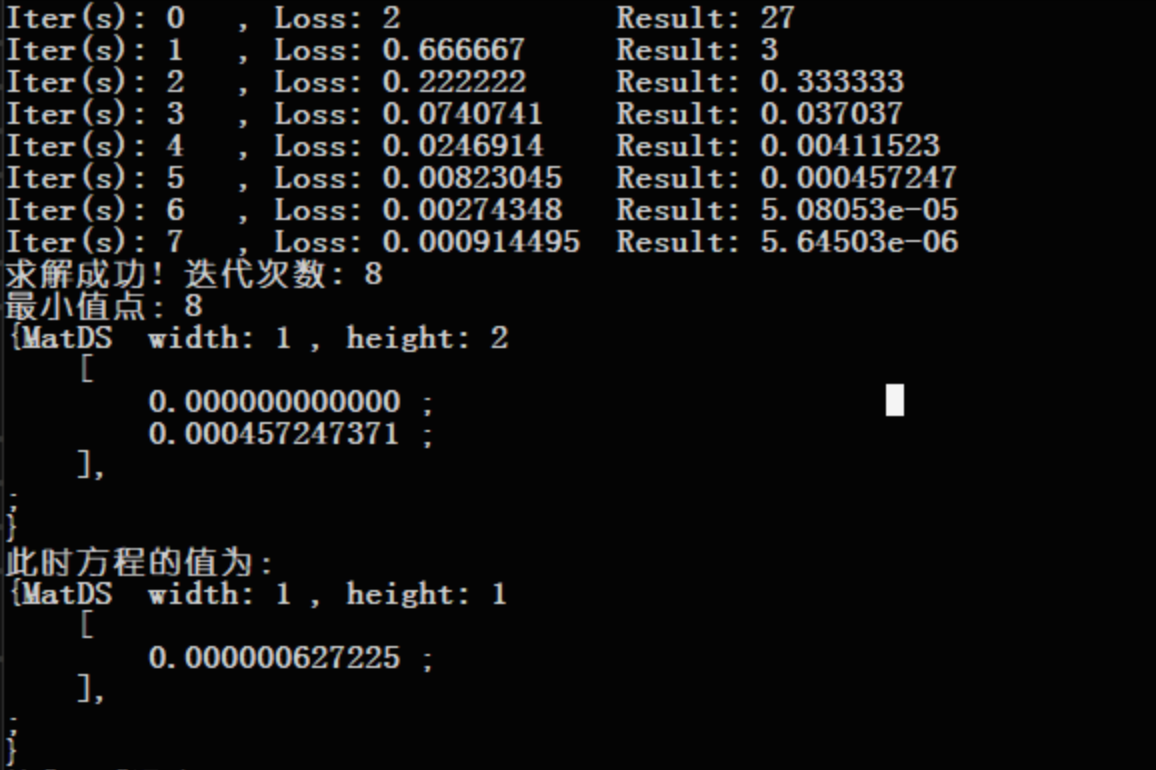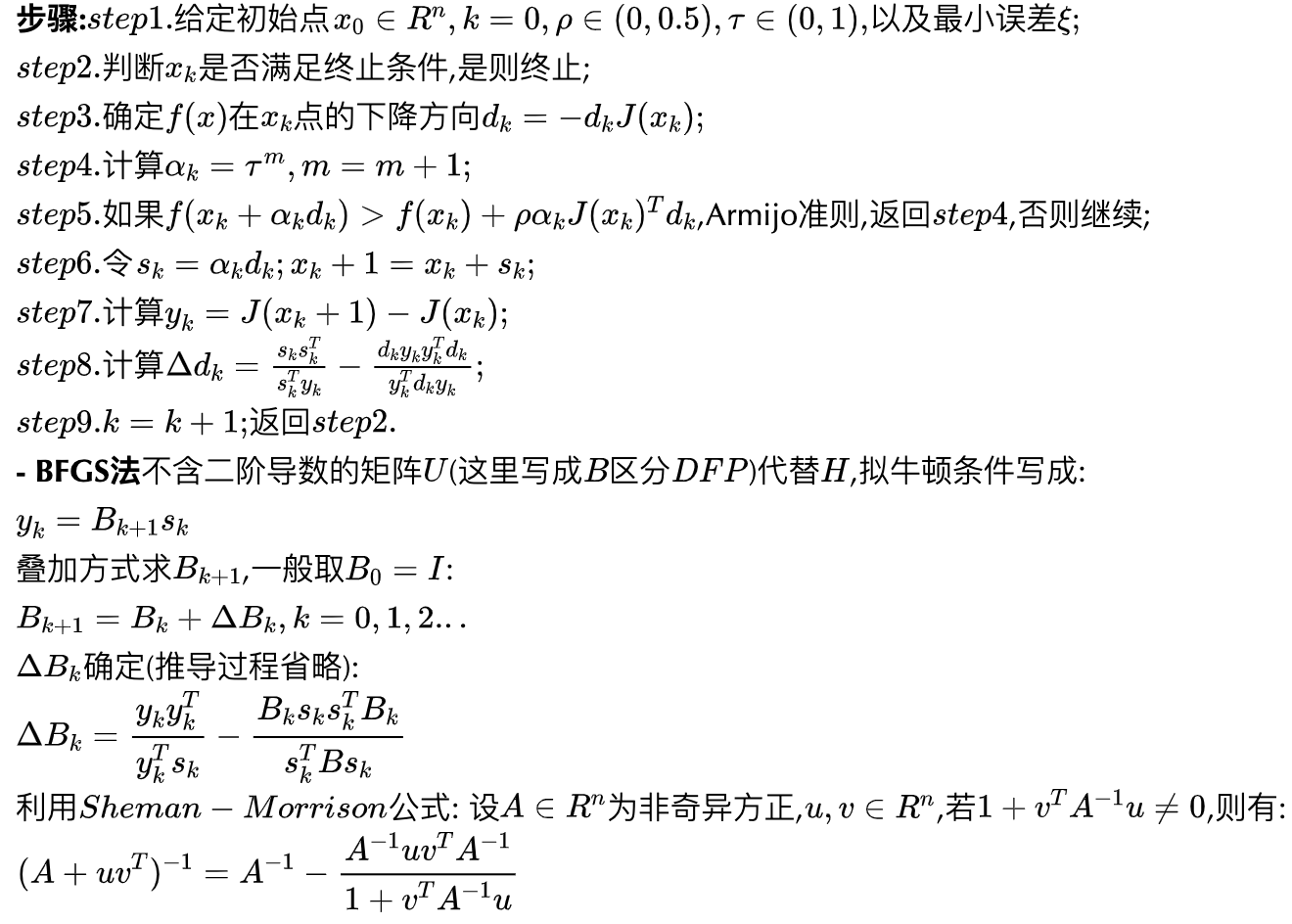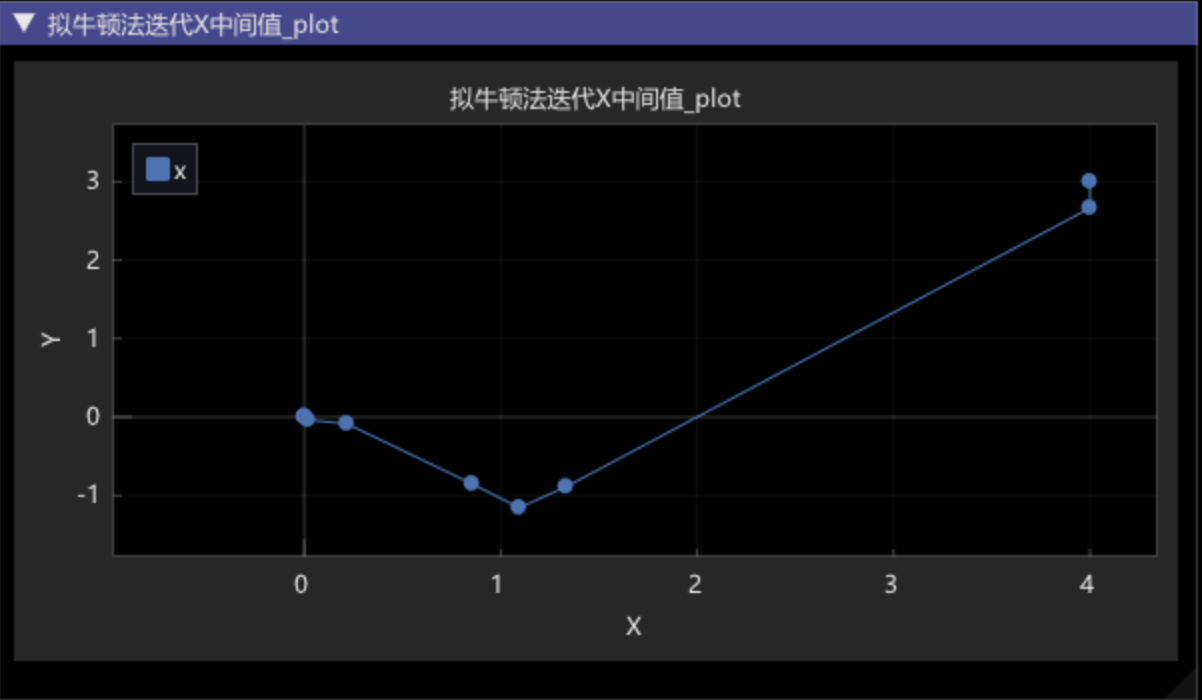1. 阻尼牛顿法
牛顿法最突出的优点是收敛速度快,具有局部二阶收敛性,但是,基本牛顿法初始点需要足够“靠近”极小点,否则,有可能导致算法不收敛。
这样就引入了阻尼牛顿法,阻尼牛顿法最核心的一点在于可以修改每次迭代的步长,通过沿着牛顿法确定的方向一维搜索最优的步长,最终选择使得函数值最小的步长。
补充:一维搜索非精确搜索方法。
- Goldstein准则(控制步长太小)
- Wolfe准则
满足Wolfe准则的点为,和区间的点.
#include <Msnhnet/math/MsnhMatrixS.h>
#include <Msnhnet/cv/MsnhCVGui.h>
#include <iostream>
using namespace Msnhnet;
class DampedNewton
{
public:
DampedNewton(int maxIter, double eps, double rho, double tau):_maxIter(maxIter),_eps(eps),_rho(rho),_tau(tau){}
void setMaxIter(int maxIter)
{
_maxIter = maxIter;
}
virtual int solve(MatSDS &startPoint) = 0;
void setEps(double eps)
{
_eps = eps;
}
void setRho(double rho)
{
_rho = rho;
}
void setTau(double tau)
{
_tau = tau;
}
//正定性判定
bool isPosMat(const MatSDS &H)
{
MatSDS eigen = H.eigen()[0];
for (int i = 0; i < eigen.mWidth; ++i)
{
if(eigen[i]<=0)
{
return false;
}
}
return true;
}
const std::vector<Vec2F32> &getXStep() const
{
return _xStep;
}
protected:
int _maxIter = 100;
double _eps = 0.00001;
double _rho = 0.2;
double _tau = 0.9;
std::vector<Vec2F32> _xStep;
protected:
virtual MatSDS calGradient(const MatSDS& point) = 0;
virtual MatSDS calHessian(const MatSDS& point) = 0;
virtual bool calDk(const MatSDS& point, MatSDS &dk) = 0;
virtual MatSDS function(const MatSDS& point) = 0;
};
class DampedNewtonProblem1:public DampedNewton
{
public:
DampedNewtonProblem1(int maxIter, double eps, double rho, double tau):DampedNewton(maxIter, eps, rho, tau){}
MatSDS calGradient(const MatSDS &point) override
{
MatSDS J(1,2);
double x1 = point(0,0);
double x2 = point(0,1);
J(0,0) = 6*x1 - 2*x1*x2;
J(0,1) = 6*x2 - x1*x1;
return J;
}
MatSDS calHessian(const MatSDS &point) override
{
MatSDS H(2,2);
double x1 = point(0,0);
double x2 = point(0,1);
H(0,0) = 6 - 2*x2;
H(0,1) = -2*x1;
H(1,0) = -2*x1;
H(1,1) = 6;
return H;
}
bool calDk(const MatSDS& point, MatSDS &dk) override
{
MatSDS J = calGradient(point);
MatSDS H = calHessian(point);
if(!isPosMat(H))
{
return false;
}
dk = -1*H.invert()*J;
return true;
}
MatSDS function(const MatSDS &point) override
{
MatSDS f(1,1);
double x1 = point(0,0);
double x2 = point(0,1);
f(0,0) = 3*x1*x1 + 3*x2*x2 - x1*x1*x2;
return f;
}
int solve(MatSDS &startPoint) override
{
MatSDS x = startPoint;
for (int i = 0; i < _maxIter; ++i)
{
_xStep.push_back({(float)x[0],(float)x[1]});
MatSDS dk;
bool ok = calDk(x, dk);
if(!ok)
{
return -2;
}
double alpha = 1;
//Armijo准则
for (int i = 0; i < 100; ++i)
{
MatSDS left = function(x + alpha*dk);
MatSDS right = function(x) + this->_rho*alpha*calGradient(x).transpose()*dk;
if(left(0,0) <= right(0,0))
{
break;
}
alpha = alpha * _tau;
}
std::cout<<std::left<<"Iter(s): "<<std::setw(4)<<i<<", Loss: "<<std::setw(12)<<dk.L2()<<" Result: "<<function(x)[0]<<std::endl;
x = x + alpha*dk;
if(dk.LInf() < _eps)
{
startPoint = x;
return i+1;
}
}
return -1;
}
};
int main()
{
DampedNewtonProblem1 function(100, 0.001, 0.4, 0.8);
MatSDS startPoint(1,2,{1.5,1.5});
try
{
int res = function.solve(startPoint);
if(res == -1)
{
std::cout<<"求解失败"<<std::endl;
}
else if(res == -2)
{
std::cout<<"Hessian 矩阵非正定, 求解失败"<<std::endl;
}
else
{
std::cout<<"求解成功! 迭代次数: "<<res<<std::endl;
std::cout<<"最小值点:"<<res<<std::endl;
startPoint.print();
std::cout<<"此时方程的值为:"<<std::endl;
function.function(startPoint).print();
#ifdef WIN32
Gui::setFont("c:/windows/fonts/MSYH.TTC",16);
#endif
std::cout<<"按\"esc\"退出!"<<std::endl;
Gui::plotLine(u8"阻尼牛顿法迭代X中间值","x",function.getXStep());
Gui::wait();
}
}
catch(Exception ex)
{
std::cout<<ex.what();
}
} 结果:对于初始点 (1.5,1.5) ,迭代4次即可完成
阻尼牛顿法,4次完成迭代
阻尼牛顿法X中间点可视化
结果:对于初始点 (0,3) ,同样是Hessian矩阵不正定.
阻尼牛顿法求解失败
2. 牛顿Levenberg-Marquardt法
步骤
举例
#include <Msnhnet/math/MsnhMatrixS.h>
#include <Msnhnet/cv/MsnhCVGui.h>
#include <iostream>
using namespace Msnhnet;
class NewtonLM
{
public:
NewtonLM(int maxIter, double eps, double vk, double rho, double tau):_maxIter(maxIter),_eps(eps),_vk(vk),_rho(rho),_tau(tau){}
void setMaxIter(int maxIter)
{
_maxIter = maxIter;
}
virtual int solve(MatSDS &startPoint) = 0;
void setEps(double eps)
{
_eps = eps;
}
void setRho(double rho)
{
_rho = rho;
}
void setTau(double tau)
{
_tau = tau;
}
//正定性判定
bool isPosMat(const MatSDS &H)
{
MatSDS eigen = H.eigen()[0];
for (int i = 0; i < eigen.mWidth; ++i)
{
if(eigen[i]<=0)
{
return false;
}
}
return true;
}
const std::vector<Vec2F32> &getXStep() const
{
return _xStep;
}
protected:
int _maxIter = 100;
double _eps = 0.00001;
double _vk = 3;
double _rho = 0.2;
double _tau = 0.9;
std::vector<Vec2F32> _xStep;
protected:
virtual MatSDS calGradient(const MatSDS& point) = 0;
virtual MatSDS calHessian(const MatSDS& point) = 0;
virtual MatSDS calDk(const MatSDS& point) = 0;
virtual MatSDS function(const MatSDS& point) = 0;
};
class NewtonLMProblem1:public NewtonLM
{
public:
NewtonLMProblem1(int maxIter, double eps, double vk, double rho, double tau):NewtonLM(maxIter, eps, vk,rho,tau){}
MatSDS calGradient(const MatSDS &point) override
{
MatSDS J(1,2);
double x1 = point(0,0);
double x2 = point(0,1);
J(0,0) = 6*x1 - 2*x1*x2;
J(0,1) = 6*x2 - x1*x1;
return J;
}
MatSDS calHessian(const MatSDS &point) override
{
MatSDS H(2,2);
double x1 = point(0,0);
double x2 = point(0,1);
H(0,0) = 6 - 2*x2;
H(0,1) = -2*x1;
H(1,0) = -2*x1;
H(1,1) = 6;
return H;
}
MatSDS calDk(const MatSDS& point) override
{
MatSDS J = calGradient(point);
MatSDS H = calHessian(point);
MatSDS I = MatSDS::eye(H.mWidth);
MatSDS Hp = H + _vk*I;
if(!isPosMat(Hp))
{
H = H + 2*_vk*I;
}
else
{
H = Hp;
}
return -1*H.invert()*J;
}
MatSDS function(const MatSDS &point) override
{
MatSDS f(1,1);
double x1 = point(0,0);
double x2 = point(0,1);
f(0,0) = 3*x1*x1 + 3*x2*x2 - x1*x1*x2;
return f;
}
int solve(MatSDS &startPoint) override
{
MatSDS x = startPoint;
for (int i = 0; i < _maxIter; ++i)
{
_xStep.push_back({(float)x[0],(float)x[1]});
//这里就不用检查正定了
MatSDS dk = calDk(x);
double alpha = 1;
//Armijo准则
for (int i = 0; i < 100; ++i)
{
MatSDS left = function(x + alpha*dk);
MatSDS right = function(x) + this->_rho*alpha*calGradient(x).transpose()*dk;
if(left(0,0) <= right(0,0))
{
break;
}
alpha = alpha * _tau;
}
std::cout<<std::left<<"Iter(s): "<<std::setw(4)<<i<<", Loss: "<<std::setw(12)<<dk.L2()<<" Result: "<<function(x)[0]<<std::endl;
x = x + alpha*dk;
if(dk.LInf() < _eps)
{
startPoint = x;
return i+1;
}
}
return -1;
}
};
int main()
{
NewtonLMProblem1 function(1000, 0.001,3, 0.4, 0.8);
MatSDS startPoint(1,2,{0,3});
try
{
int res = function.solve(startPoint);
if(res < 0)
{
std::cout<<"求解失败"<<std::endl;
}
else
{
std::cout<<"求解成功! 迭代次数: "<<res<<std::endl;
std::cout<<"最小值点:"<<res<<std::endl;
startPoint.print();
std::cout<<"此时方程的值为:"<<std::endl;
function.function(startPoint).print();
#ifdef WIN32
Gui::setFont("c:/windows/fonts/MSYH.TTC",16);
#endif
std::cout<<"按\"esc\"退出!"<<std::endl;
Gui::plotLine(u8"牛顿LM法迭代X中间值","x",function.getXStep());
Gui::wait();
}
}
catch(Exception ex)
{
std::cout<<ex.what();
}
}
结果: 对于初始点 (0,3) ,迭代8次即可完成,解决了Newton法Hessian矩阵不正定的问题.
3.拟牛顿法
举例
#include <Msnhnet/math/MsnhMatrixS.h>
#include <Msnhnet/cv/MsnhCVGui.h>
#include <iostream>
using namespace Msnhnet;
class NewtonLM
{
public:
NewtonLM(int maxIter, double eps, double vk, double rho, double tau):_maxIter(maxIter),_eps(eps),_vk(vk),_rho(rho),_tau(tau){}
void setMaxIter(int maxIter)
{
_maxIter = maxIter;
}
virtual int solve(MatSDS &startPoint) = 0;
void setEps(double eps)
{
_eps = eps;
}
void setRho(double rho)
{
_rho = rho;
}
void setTau(double tau)
{
_tau = tau;
}
//正定性判定
bool isPosMat(const MatSDS &H)
{
MatSDS eigen = H.eigen()[0];
for (int i = 0; i < eigen.mWidth; ++i)
{
if(eigen[i]<=0)
{
return false;
}
}
return true;
}
const std::vector<Vec2F32> &getXStep() const
{
return _xStep;
}
protected:
int _maxIter = 100;
double _eps = 0.00001;
double _vk = 3;
double _rho = 0.2;
double _tau = 0.9;
std::vector<Vec2F32> _xStep;
protected:
virtual MatSDS calGradient(const MatSDS& point) = 0;
virtual MatSDS calHessian(const MatSDS& point) = 0;
virtual MatSDS calDk(const MatSDS& point) = 0;
virtual MatSDS function(const MatSDS& point) = 0;
};
class NewtonLMProblem1:public NewtonLM
{
public:
NewtonLMProblem1(int maxIter, double eps, double vk, double rho, double tau):NewtonLM(maxIter, eps, vk,rho,tau){}
MatSDS calGradient(const MatSDS &point) override
{
MatSDS J(1,2);
double x1 = point(0,0);
double x2 = point(0,1);
J(0,0) = 6*x1 - 2*x1*x2;
J(0,1) = 6*x2 - x1*x1;
return J;
}
MatSDS calHessian(const MatSDS &point) override
{
MatSDS H(2,2);
double x1 = point(0,0);
double x2 = point(0,1);
H(0,0) = 6 - 2*x2;
H(0,1) = -2*x1;
H(1,0) = -2*x1;
H(1,1) = 6;
return H;
}
MatSDS calDk(const MatSDS& point) override
{
MatSDS J = calGradient(point);
MatSDS H = calHessian(point);
MatSDS I = MatSDS::eye(H.mWidth);
MatSDS Hp = H + _vk*I;
if(!isPosMat(Hp))
{
H = H + 2*_vk*I;
}
else
{
H = Hp;
}
return -1*H.invert()*J;
}
MatSDS function(const MatSDS &point) override
{
MatSDS f(1,1);
double x1 = point(0,0);
double x2 = point(0,1);
f(0,0) = 3*x1*x1 + 3*x2*x2 - x1*x1*x2;
return f;
}
int solve(MatSDS &startPoint) override
{
MatSDS x = startPoint;
for (int i = 0; i < _maxIter; ++i)
{
_xStep.push_back({(float)x[0],(float)x[1]});
//这里就不用检查正定了
MatSDS dk = calDk(x);
double alpha = 1;
//Armijo准则
for (int i = 0; i < 100; ++i)
{
MatSDS left = function(x + alpha*dk);
MatSDS right = function(x) + this->_rho*alpha*calGradient(x).transpose()*dk;
if(left(0,0) <= right(0,0))
{
break;
}
alpha = alpha * _tau;
}
std::cout<<std::left<<"Iter(s): "<<std::setw(4)<<i<<", Loss: "<<std::setw(12)<<dk.L2()<<" Result: "<<function(x)[0]<<std::endl;
x = x + alpha*dk;
if(dk.LInf() < _eps)
{
startPoint = x;
return i+1;
}
}
return -1;
}
};
int main()
{
NewtonLMProblem1 function(1000, 0.001,3, 0.4, 0.8);
MatSDS startPoint(1,2,{0,3});
try
{
int res = function.solve(startPoint);
if(res < 0)
{
std::cout<<"求解失败"<<std::endl;
}
else
{
std::cout<<"求解成功! 迭代次数: "<<res<<std::endl;
std::cout<<"最小值点:"<<res<<std::endl;
startPoint.print();
std::cout<<"此时方程的值为:"<<std::endl;
function.function(startPoint).print();
#ifdef WIN32
Gui::setFont("c:/windows/fonts/MSYH.TTC",16);
#endif
std::cout<<"按\"esc\"退出!"<<std::endl;
Gui::plotLine(u8"牛顿LM法迭代X中间值","x",function.getXStep());
Gui::wait();
}
}
catch(Exception ex)
{
std::cout<<ex.what();
}
}
结果:对于初始点 (4,3) ,迭代9次即可完成,此点Newton法,DFP法都无解,BFGS方法有解,一般来说BFGS效果比较好.
拟牛顿法9次完成求解
拟牛顿法X中间值可视化
4. 源码
https://github.com/msnh2012/n...https://github.com/msnh2012/numerical-optimizaiton)
5. 依赖包
https://github.com/msnh2012/M...https://github.com/msnh2012/Msnhnet)
6. 参考文献
- Numerical Optimization. Jorge Nocedal Stephen J. Wrigh
- Methods for non-linear least squares problems. K. Madsen, H.B. Nielsen, O. Tingleff.
- Practical Optimization\_ Algorithms and Engineering Applications. Andreas Antoniou Wu-Sheng Lu
- 最优化理论与算法. 陈宝林
- 数值最优化方法. 高立
网盘资料下载:链接:https://pan.baidu.com/s/1hpFw... 提取码:b6gq
7. 最后
- 欢迎关注我和BBuf及公众号的小伙伴们一块维护的一个深度学习框架Msnhnet: https://github.com/msnh2012/M... Msnhnet除了是一个深度网络推理库之外,还是一个小型矩阵库,包含了矩阵常规操作,LU分解,Cholesky分解,SVD分解。
END
原文:GiantPandaCV
作者:msnh2012
推荐阅读
更多嵌入式AI技术干货请关注嵌入式AI专栏。


